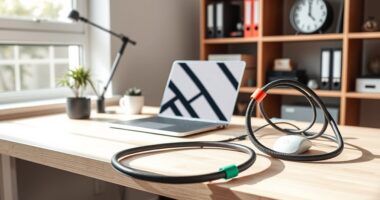To reduce eye strain at work, follow the 20-20-20 rule—look away from your screen every 20 minutes and focus on something 20 feet away for at least 20 seconds. Adjust your monitor’s brightness and contrast to match your environment, keeping it at eye level and about an arm’s length away. Use proper lighting, avoid glare, and take regular breaks to stretch and hydrate. Keep your eyes moist, and if you stay attentive, you’ll discover even more helpful tips.
Key Takeaways
- Adjust monitor height and distance to align with your eye level and keep about an arm’s length away.
- Use proper lighting, diffuse sunlight, and reduce glare with anti-glare filters and adjustable lamps.
- Follow the 20-20-20 rule: look away every 20 minutes at an object 20 feet away for 20 seconds.
- Keep eyes moisturized with drops, stay hydrated, and maintain good air quality to prevent dryness.
- Take regular breaks to stretch and perform eye exercises to relax eye muscles and reduce fatigue.
Follow the 20-20-20 Rule
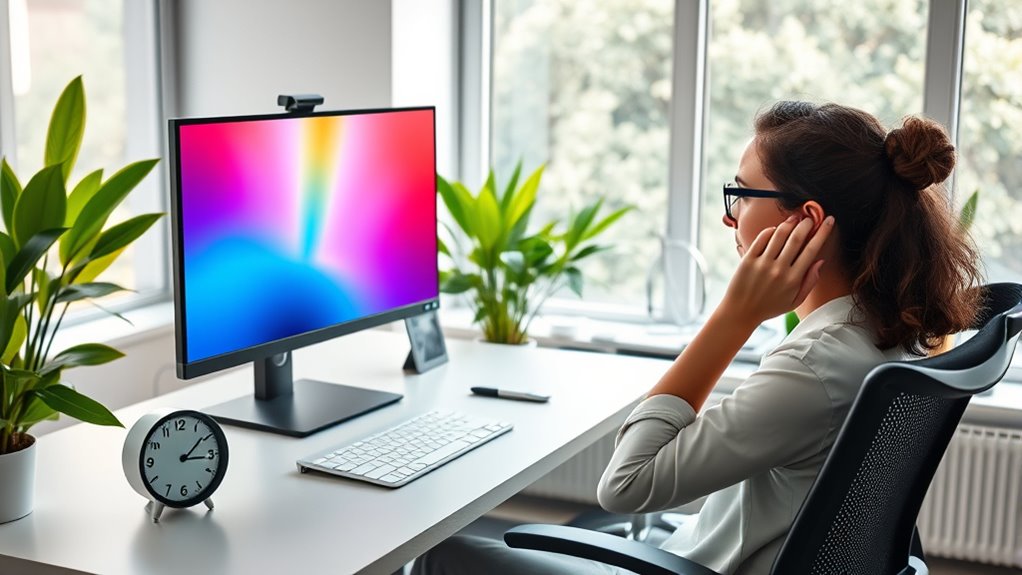
To reduce eye strain during long hours at your desk, it’s important to follow the 20-20-20 rule. Every 20 minutes, look away from your screen and focus on an object at least 20 feet away for at least 20 seconds. This simple habit helps relieve eye fatigue caused by prolonged screen time. When you neglect this practice, visual distraction can increase, making it harder to concentrate and causing discomfort. Regularly shifting your focus reduces strain on your eye muscles and minimizes symptoms like dryness and headaches. Additionally, using headphones, especially wireless or noise-canceling models, can help create a more focused work environment and reduce the need for constant visual attention. Incorporating essential oils for eye health, such as lavender or peppermint, into your relaxation routine may also promote eye comfort and reduce strain. Moreover, maintaining proper screen brightness and contrast can further alleviate stress on your eyes. Ensuring your workspace has good air quality can also contribute to overall eye comfort, especially if you’re using an air purifier to reduce airborne irritants. By incorporating the 20-20-20 rule into your routine, you give your eyes a much-needed break, preventing eye fatigue and improving overall comfort during work hours. Consistency is key to maintaining healthy vision and reducing unnecessary stress on your eyes.
Adjust Your Screen Brightness and Contrast
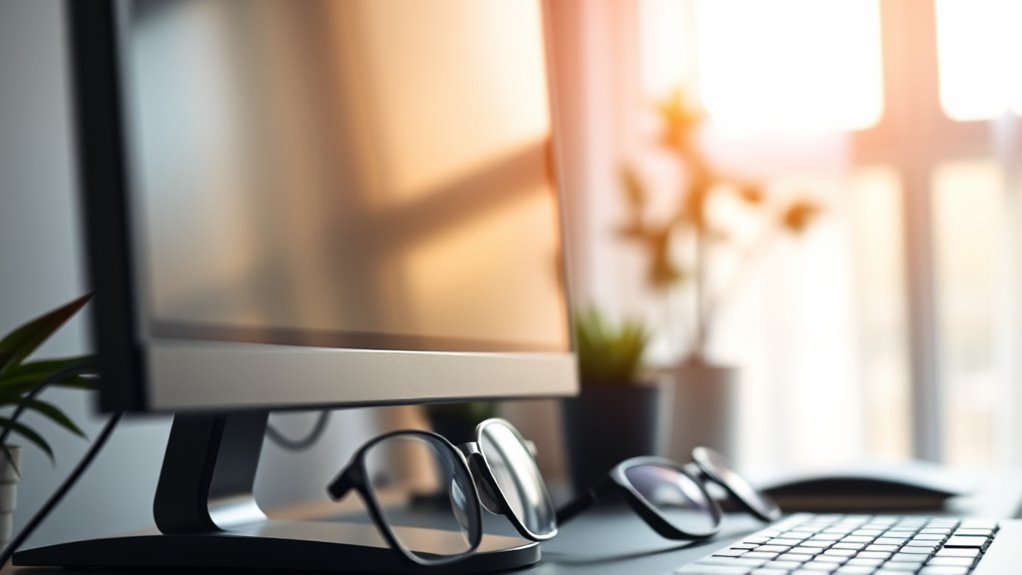
After practicing the 20-20-20 rule, adjusting your screen brightness and contrast can further ease eye strain. Proper screen calibration guarantees your display settings match your environment, reducing glare and discomfort. To optimize your display settings:
- Use automatic brightness adjustment if available, and manually fine-tune your brightness to match ambient lighting.
- Set contrast to a level that makes text clear without causing eye fatigue.
- Avoid high brightness in dim environments, which can strain your eyes.
- Regularly calibrate your monitor to maintain consistent display settings.
- Incorporate color accuracy practices to ensure your display’s color settings are optimized for reduced eye fatigue and better visual comfort throughout your workday. Additionally, selecting displays with high vetted quality can further enhance your viewing experience and reduce strain.
- Consider using professional calibration tools to achieve the most precise display settings for your workspace.
Position Your Monitor Correctly
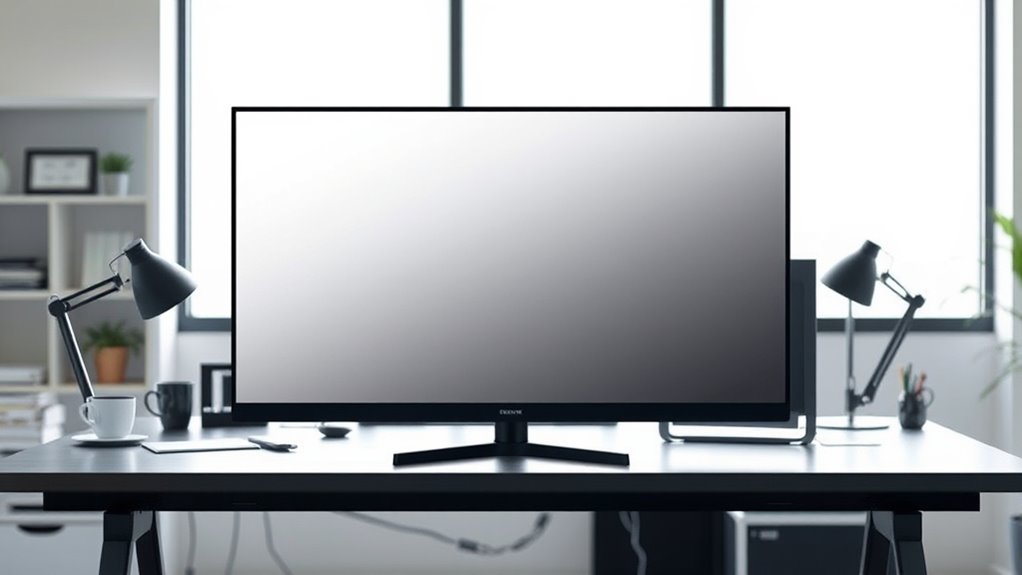
Make sure your monitor is at eye level so you don’t strain your neck or eyes. Keep it about an arm’s length away to reduce eye fatigue. Proper positioning helps you work comfortably and minimizes unnecessary eye strain. Additionally, adjusting your monitor’s lighting conditions can help optimize your workspace setup for better comfort. Ensuring that your monitor’s positioning prevents glare and reflections further reduces eye discomfort, especially as automation technologies increasingly influence ergonomic solutions.
Eye Level Alignment
Positioning your monitor at eye level is essential for reducing eye strain during long work hours. When your screen is too high or low, it causes unnecessary neck and eye tension. To guarantee proper alignment:
- Sit in an ergonomic chair that supports good posture.
- Adjust your monitor so the top of the screen is at or just below eye level.
- Keep the screen about an arm’s length away to avoid leaning forward.
- Incorporate regular eye exercises to relax your eyes and reduce fatigue.
- Using crochet techniques to maintain proper posture can help prevent strain during extended periods of work or craft activities. Additionally, ensuring your workspace is set up according to ergonomic principles can further prevent discomfort and promote overall well-being. Proper monitor positioning not only minimizes strain but also encourages ergonomic habits that promote overall comfort. Aligning your monitor correctly minimizes strain and helps maintain a natural neck position. Regularly adjusting your workspace to accommodate advances in ergonomic design can further improve comfort during long work sessions. Remember, proper eye level setup combined with ergonomic furniture and eye exercises will considerably improve comfort during extended work sessions.
Proper Monitor Distance
Ensuring your monitor is at the right distance helps reduce eye strain and promotes better posture. Position your screen about an arm’s length away, with the top of the monitor roughly at eye level. This setup minimizes eye fatigue and encourages a neutral neck position. Sit in an ergonomic chair that supports good posture, and make sure your keyboard placement allows your elbows to stay close to your sides and your wrists straight. Keep the monitor directly in front of you to avoid unnecessary twisting of your neck. Adjusting the monitor distance and alignment reduces strain on your eyes and neck, helping you work longer without discomfort. Proper monitor positioning is a simple yet effective way to protect your eyes and maintain good ergonomic habits. Incorporating ergonomic workspace setup principles can further enhance comfort and reduce strain during long hours at your desk, especially when combined with appropriate air quality improvements to create a healthier work environment.
Use Proper Lighting in Your Workspace
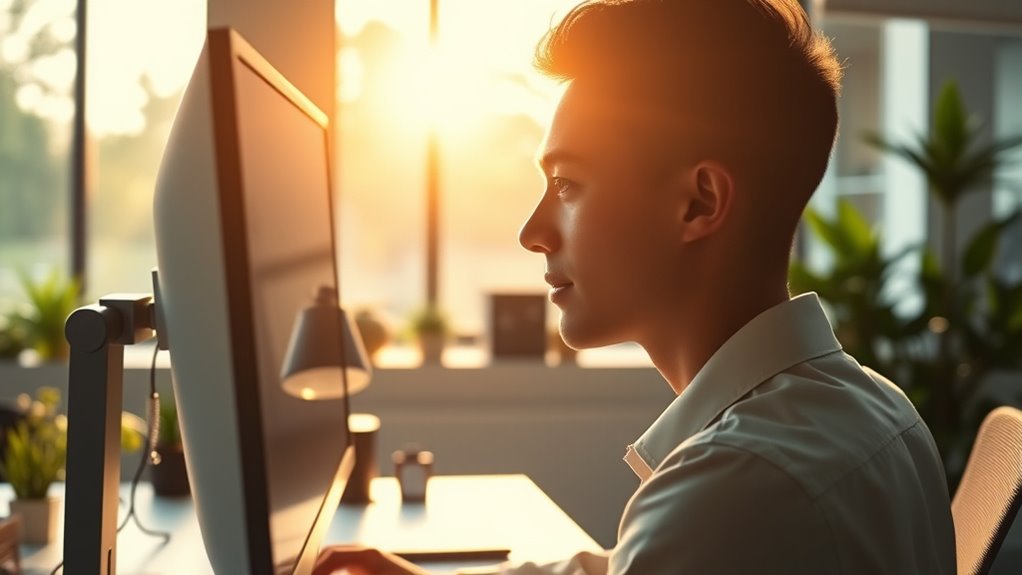
Using proper lighting can make a big difference in reducing eye strain. Take advantage of natural light when possible, but be mindful to avoid glare and reflections on your screen. Adjust your light intensity so it’s comfortable and evenly lit to keep your eyes from working harder than they need to. Incorporating proper lighting practices can further optimize your workspace environment for eye health. Additionally, choosing lighting that minimizes glare and reflections can significantly decrease eye fatigue during extended periods of work. Ensuring your workspace has adequate light levels tailored to your specific environment can also help prevent unnecessary eye strain. Staying informed about AI-driven security systems can also help protect your digital workspace and personal data.
Natural Light Benefits
Natural light plays an essential role in reducing eye strain by providing a more comfortable and consistent source of illumination. Increased daylight exposure helps your eyes focus naturally, reducing fatigue. To maximize these benefits, consider:
- Position your desk near a window to get ample natural light during the day.
- Take short breaks outdoors to boost your natural light intake.
- Use sheer curtains to diffuse sunlight, preventing harsh glares.
- Adjust your workspace layout to ensure natural light illuminates your screen evenly.
- Incorporate ergonomic practices in your routine by being mindful of how natural light influences focus and comfort throughout your workday. Additionally, understanding the importance of AI safety can help you stay informed about technological advancements that may impact workplace environments in the future.
Avoid Glare and Reflection
Maximizing natural light while minimizing glare is key to reducing eye strain at work. Screen glare from windows or bright lights can cause discomfort and make it harder to see your screen clearly. To prevent this, position your monitor to avoid reflections from windows or overhead lights. Use curtains or blinds to control natural light and reduce reflection reduction. If you work with a reflective screen, consider an anti-glare filter to cut down on screen glare. Adjusting the placement of your workspace can also help minimize unwanted reflections. Keep lights at a comfortable level and avoid direct light hitting your monitor. By managing glare and reflection, you’ll create a more comfortable environment that protects your eyes throughout the workday.
Adjust Light Intensity
Proper lighting is essential for reducing eye strain at work, as harsh or insufficient illumination can cause your eyes to work harder and lead to discomfort. To optimize your workspace, consider these steps:
- Adjust your ambient light control to create a balanced environment, avoiding glare and shadows.
- Use adjustable lamps to fine-tune light intensity based on your needs.
- Calibrate your screen color settings to reduce eye fatigue, ensuring colors are comfortable and natural.
- Maintain a consistent light level that isn’t too bright or dim, supporting better focus and less strain.
Take Regular Breaks and Stretch
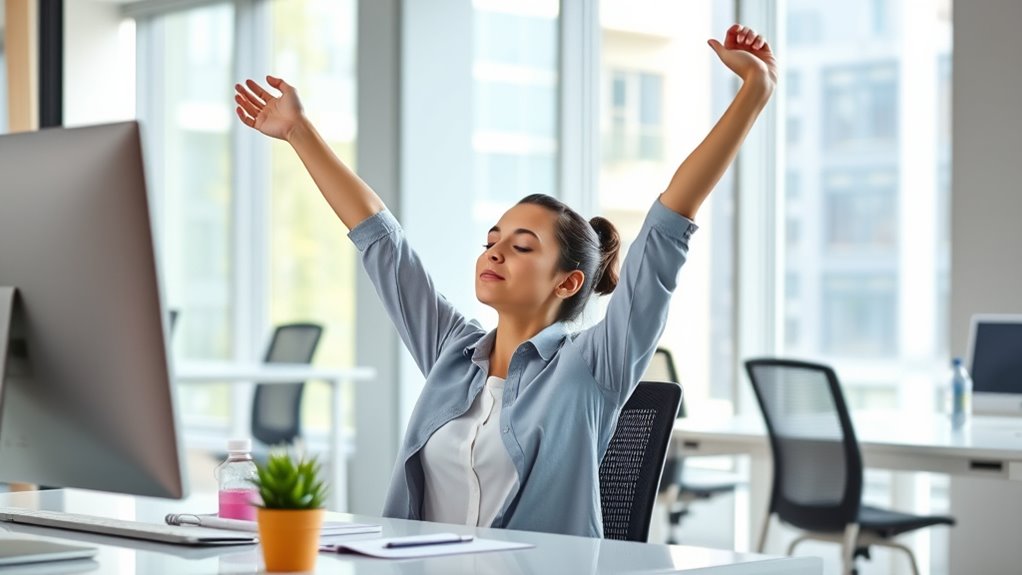
Taking regular breaks and stretching throughout your workday can considerably reduce eye strain and prevent fatigue. Every 20 minutes, look away from your screen and focus on a distant object to perform quick eye exercises, easing tension. Stand up and stretch your arms, neck, and shoulders to improve blood flow and relax tight muscles. Make sure your seating is ergonomic, supporting proper posture and reducing strain on your eyes and neck. Taking these short breaks helps reset your eyes and keeps you alert. Incorporate movement into your routine, and avoid sitting in the same position for long periods. Consistent stretching and breaks not only ease eye discomfort but also boost your overall comfort and productivity during work.
Keep Your Eyes Moisturized and Stay Hydrated

Since dry eyes can worsen eye strain, staying moisturized is essential when working at a computer. To keep your eyes comfortable, consider these tips:
Staying hydrated and using eye drops helps prevent dry eyes and reduces eye strain during computer work.
- Use eye drops to provide quick relief and restore moisture.
- Apply moisturizing gels to soothe your eyes during long work sessions.
- Drink plenty of water throughout the day to stay hydrated internally.
- Avoid environments with dry air; use a humidifier if needed.
These habits help prevent dryness and reduce discomfort. Regular use of eye drops or gels keeps your eyes lubricated, decreasing irritation. Staying hydrated supports your eye health from the inside out. By combining these practices, you’ll minimize eye strain and maintain clearer, more comfortable vision during work hours.
Frequently Asked Questions
How Can I Tell if My Screen Is Causing Eye Strain?
If you notice eye fatigue, dryness, or headaches after looking at your screen, it’s a sign your screen might be causing eye strain. Check if your screen brightness matches your environment; too bright or too dim can cause discomfort. Also, observe if your eyes feel tired or sore after extended use. These symptoms indicate your screen could be contributing to your eye strain, so adjusting brightness and taking breaks can help.
Are There Specific Glasses That Can Reduce Eye Strain?
Think of your glasses as shields for your eyes. Yes, there are specific glasses like blue light glasses that block harmful wavelengths from screens. Look for options with anti-reflective coatings; they reduce glare and eye fatigue. These glasses are designed to keep your eyes comfortable during long hours at work, helping you stay focused and reducing strain. Investing in the right pair can make a noticeable difference in your daily screen time.
What Are Symptoms of Prolonged Eye Strain?
Prolonged eye strain often causes digital eye fatigue, leading to symptoms like headaches, blurred vision, and dry eyes. You might notice discomfort after long hours at your computer or screen. Poor workspace ergonomics can worsen these symptoms, making it harder to focus and causing eye discomfort. To prevent this, take regular breaks, adjust your screen position, and guarantee proper lighting to reduce digital eye fatigue and improve overall comfort at work.
Can Eye Exercises Help Alleviate Eye Strain?
Yes, eye exercises can help alleviate eye strain. Engaging in eye relaxation techniques, like focusing on distant objects or blinking frequently, reduces fatigue. Vision therapy exercises strengthen eye muscles and improve focus, easing discomfort. Regularly practicing these exercises during work breaks helps prevent strain buildup. Incorporate simple routines to keep your eyes relaxed, maintain clear vision, and reduce symptoms associated with prolonged screen time.
How Does Blue Light Affect Eye Health?
Blue light can contribute to eye fatigue, especially after long screen time. When you’re exposed to blue light, your eyes work harder to focus, which can cause discomfort and strain. Prolonged exposure may also disrupt your sleep patterns. To protect your eye health, consider using screen filters or glasses that block blue light, take regular breaks, and practice the 20-20-20 rule to reduce eye fatigue.
Conclusion
By following these tips, you’ll notice your eye strain easing, almost like a coincidence. As you take regular breaks and adjust your workspace, your eyes will thank you unexpectedly. Staying hydrated and keeping your eyes moisturized can feel like a small effort for big relief. So, next time you sit at your desk, remember these simple steps—they might just turn your workday into a more comfortable, strain-free experience without even trying.


